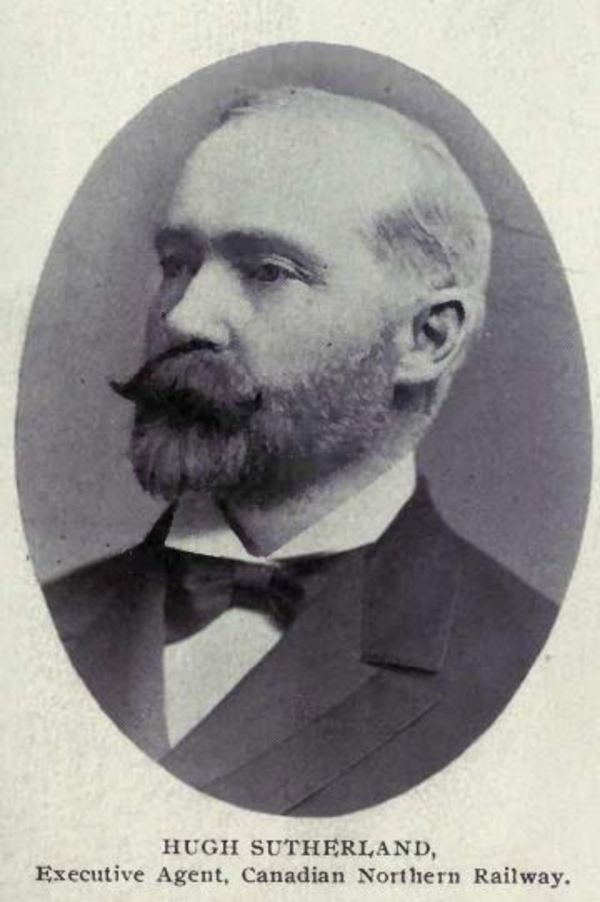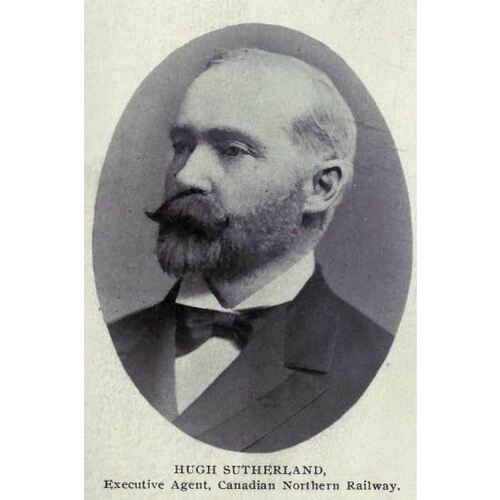
Source: Link
SUTHERLAND, HUGH McKAY, lumberman, office holder, politician, and railway promoter; b. 22 Feb. 1843 in New London, P.E.I., son of Donald Sutherland and Euphemia ———; m. first 10 Feb. 1864 Mary Dickie (d. 1875) of Brantford, Upper Canada; m. secondly 10 Dec. 1878 May Banks of Baltimore, Md; m. thirdly 3 Sept. 1921 Constance Margaret Denholm (d. 1925) in Winnipeg; he was survived by two daughters; d. 14 Aug. 1926 in Croydon (London), England, and was buried in Winnipeg.
In 1849 Hugh Sutherland’s family moved to Oxford County, Upper Canada, and he attended school there. Afterwards, he worked as a bookkeeper in Ingersoll for lumberman and Liberal politician Adam Oliver*. In 1867, with Oliver and William Cairns Bell, he became a partner in Adam Oliver Company. The following year the company established a planing mill and lumberyard in Orillia. Although the mill and yard were destroyed by fire in 1871 and the partnership was dissolved, Sutherland continued in the lumber business in Orillia; by 1875 he owned a sawmill there.
Sutherland had taken a keen interest in local Liberal politics while in Ingersoll. The victory by the Liberals under Alexander Mackenzie* in the federal election of 1874 brought him an appointment as the superintendent of public works for the North-West Territories, a position he held until the defeat of the Liberals in 1878. While in the west, he unsuccessfully contested the seat of Simcoe East for the Liberals in the Ontario general election of 1875.
Sutherland’s term in government service gave him incomparable insights into the rich resources of the west and the transportation facilities needed to exploit and develop them. In 1878 he settled permanently in Winnipeg. He became an exceptionally enthusiastic promoter of western Canada and in the early 1880s participated in the formation of several mining, land, and navigation companies. His most spectacular, but brief, successes came in the lumber business. The phenomenal boom associated with the early construction of the Canadian Pacific Railway created an enormous demand for lumber in Winnipeg in 1881 and 1882. Sutherland obtained numerous timber leases and then built what was allegedly the first large sawmill (with a capacity of 40,000 board feet per day) in Winnipeg and another at Rat Portage (Kenora, Ont.). At the peak of his operations in 1882 he employed 300 men and had recently obtained a timber limit for 64,000 acres of choice pine timber. The collapse of the Winnipeg real estate and housing boom in 1883 severely curtailed his timber operations, however. In 1882, at the height of his business career, he had been elected to the House of Commons for the riding of Selkirk, defeating Stewart Mulvey*, but he lost his bid for re-election to William Bain Scarth* in 1887, when his business affairs were in serious disarray. In parliament he had been an enthusiastic advocate of Manitoba and western Canadian interests, frequently denouncing federal policies which he thought retarded western development.
In the early 1880s Sutherland had also been a promoter of several railway projects. The first was the Manitoba South-Western Colonization Railway, incorporated in 1879, whose objectives were twofold. The early plans of the CPR were to build through Selkirk, bypassing Winnipeg. The Manitoba South-Western, with possible connections to the Northern Pacific Railroad in the United States, was designed to protect Winnipeg’s interests. Its second goal was the development of the Souris coalfields, which had allegedly been discovered by Sutherland. The Manitoba South-Western fulfilled both of these objectives when the CPR acquired it in 1884, re-routed the CPR main line through Winnipeg, and assisted in the development of the coalfields.
Sutherland’s second railway scheme involved the building of a line from Winnipeg northward to a port on Hudson Bay. Under his tutelage the Winnipeg and Hudson’s Bay Railway and Steamship Company was incorporated in 1880, but it faced immediate competition with the Nelson Valley Railway and Transportation Company, which was also incorporated that year. After some wrangling the two companies were amalgamated in 1883 under Sutherland’s leadership. The first 40 miles of the proposed railway was built in 1886, but a financial scandal involving provincial treasurer Alphonse-Alfred-Clément La Rivière halted construction before the contractors could be paid.
When prospects of federal aid improved in the 1890s, Donald Mann*, one of the contractors who had built the first 40 miles, used his unsatisfied claims to gain control of the railway. Mann, in partnership with William Mackenzie, then changed the route and amalgamated the line with others to form the Canadian Northern Railway in December 1898. The loss of his railway marked the end of Sutherland’s career as an independent railway promoter. The best he could do, and that only after some hard infighting, was to secure appointment as the Canadian Northern’s agent at Winnipeg. Later, he served in other firms controlled by Mackenzie and Mann, as president of the Rainy River Lumber Company (a company he had founded), the Canadian Northern Coal and Ore Dock Company, and the Canadian Northern Prairie Lands Company, and as a director and promoter of several others.
When the financial and railway projects of Mackenzie and Mann collapsed in 1918, Sutherland retired to England. He died there in 1926. He had been actively connected with the development of the Canadian west over a period of more than 40 years. Many of his business ventures prospered, but he failed in the greatest effort of his life, the building of a railway to Hudson Bay. He is, nevertheless, regarded as “the father of the Hudson Bay route.” The project was completed only after his death and has been repeatedly threatened with abandonment, but it is still capable of provoking intense political reaction from true believers.
AO, RG 80-27-2, 1: 150. Man., Dept. of Finance, Consumer and Corporate Affairs, Vital statistics (Winnipeg), no.1921-034353. Manitoba Free Press, 16 Aug. 1926. Canadian directory of parl. (Johnson). Canadian men and women of the time (Morgan; 1912). CPG, 1875, 1883, 1887. George Emery, “Adam Oliver, Ingersoll and Thunder Bay district, 1850–82,” OH, 68 (1976): 25–43. H. A. Fleming, Canada’s Arctic outlet: a history of the Hudson Bay Railway (Berkeley, Calif., 1957; repr. Westport, Conn., 1978). T. D. Regehr, The Canadian Northern Railway, pioneer road of the northern prairies, 1895–1918 (Toronto, 1976). G. R. Stevens, Canadian National Railways (2v., Toronto and Vancouver, 1960–62).
Cite This Article
Theodore D. Regehr, “SUTHERLAND, HUGH McKAY,” in Dictionary of Canadian Biography, vol. 15, University of Toronto/Université Laval, 2003–, accessed November 22, 2024, https://www.biographi.ca/en/bio/sutherland_hugh_mckay_15E.html.
The citation above shows the format for footnotes and endnotes according to the Chicago manual of style (16th edition). Information to be used in other citation formats:
| Permalink: | https://www.biographi.ca/en/bio/sutherland_hugh_mckay_15E.html |
| Author of Article: | Theodore D. Regehr |
| Title of Article: | SUTHERLAND, HUGH McKAY |
| Publication Name: | Dictionary of Canadian Biography, vol. 15 |
| Publisher: | University of Toronto/Université Laval |
| Year of publication: | 2005 |
| Year of revision: | 2013 |
| Access Date: | November 22, 2024 |



